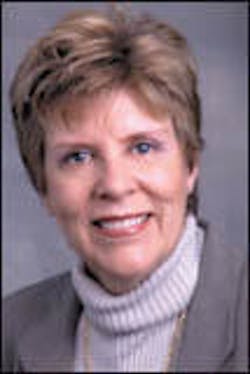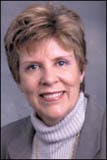Saying it right!
A valuable marketing strategy to enhance your profitability.
by Ann Hilliard, RN
An old adage oft repeated by parents and teachers is "Practice makes perfect." Unfortunately, many relate it only to manual tasks requiring physical dexterity or to the artistic or performance community. Rehearsals are routine when Julia Roberts or Will Smith are preparing for a movie. Recordings by Faith Hill or Michael Jackson are the result of hours of work in preparation. The Mormon Tabernacle Choir does not assemble and then decide what music to perform. No movie producer or director ever began filming with only inspiration or a vague concept of the final result. It always is planned. It always is written down. The artists always have a script.
In advance of a presidential news conference, the President prepares and rehearses the best answers to potential questions. Before the play, the lines are memorized. Before the concert, the choir and orchestra spend hours practicing each part so the public performance will be a seamless blend of voices and instruments. The news conference, the play, and the concert are all the result of careful planning and highly focused teamwork. The intense behind-the-scenes preparation pays off in a seemingly flawless moment in time.
Many orthodontic offices acknowledge the importance of communication skills in appointing new patients, case acceptance, and word-of-mouth advertising. The best orthodontic offices have one thing in common: They have planned and rehearsed to assure the quality of the communication of each team member with each patient or potential patient. They are prepared. They have well-considered answers to the most common questions and situations that arise. They have scripted the best responses and they practice, practice, practice!
Every day, doctors allow unseasoned staff members to represent them and their vision of quality treatment to parents, patients, and the community. These doctors depend on their employees to say the "right thing" in the "right way" with little or no consideration of the expertise or understanding of the employee.
Certainly, many talented communicators become valuable members of the orthodontic staff. They learn quickly by reading articles, and they actively practice job-improvement skills. They think carefully before answering questions and learn specific and effective wordings from the doctor and other gifted team members. But an equal number of team members have only a vague idea of how to translate the doctor's commitment to customer service and quality treatment into strong word-of-mouth advertising for the practice. These employees have little or no training; each response to a common situation may be different. The message is often obscured by its delivery.
As the owner of an orthodontic practice, imagine yourself wincing as you overhear your scheduling coordinator tell a patient, "The doctor is way too busy to work you in," or hear a clinical staff member say, "At the rate you're going, you'll never finish treatment unless you wear your elastics!" Consider the impact those unplanned comments may have on future referrals from both the primary-care dentist and the patient. Staff members represent the doctor; in the eyes of the community, their comments are the doctor's comments. Even more important, the communication that comes from the office represents the orthodontist's attention to detail and commitment to customer service.
The scheduling coordinator will be more effective if she knows to say, "I'm sorry, all of our appointments are scheduled for today." The clinical assistant will gain more cooperation if she communicates the benefits the patient will receive: "Wearing your elastics every day will help ensure your treatment is completed in the shortest amount of time!" Every verbal interaction should reinforce the message that the patient is valued and respected. Only a slight change in the way we say something can completely alter how the listener interprets the message. With scripts, you and your team have an opportunity to develop the responses that support and clarify the content you want to deliver to your patients.
Most communication experts agree that if the question or situation arises more than twice, the response should be scripted. The doctor and staff of the exceptional practice understand the importance of tactful speech. They use relationship strategies to enhance their image in the marketplace. Excellent verbal skills can be learned, and the daily use of them is one of the hallmarks of the high-level practice. An alternative is to prepare a scripting notebook for the office.
A "scripting notebook" is not meant to supply verbatim responses, but rather to provide guidelines for key words and phrases. Much like the development of a mission statement, a large part of the value in the development of scripts is in the team discussions that must take place in order to complete the project. Most importantly, the documentation helps staff to communicate your philosophies when answering critical questions and delivering information. This becomes the basis of all word-of-mouth advertising for your practice. What a powerful marketing tool!
Getting started
The initial team meeting should be planned with a minimum of one-and-a-half hours of non-patient time dedicated entirely to this project. The doctor or staff leader should be prepared and ready to facilitate the brainstorming session, and all participants should have a clear idea of the goal of the meeting. First, the team members should list all of the challenging situations where good communication is critical. For example, scheduling a mid-morning appointment for breakage repair, the recurring "compliance" patient, discussion of unpopular office policies, or even development of a brochure or language in a letter — all these situations (and potentially many others), require clear communication. If possible, the team should have a flip chart and markers available to record the ideas of each staff member. As with all brainstorming sessions, each idea should be acknowledged and recorded without immediate regard to its merit. (No evaluations at this point!) Be certain that all team members have participated and have had an opportunity to describe the communication situations that are most difficult for them.
Next, the doctor or staff leader should assist the staff in prioritizing the list. Psychologists tell us that it takes 21 days to develop a new skill. Changing the language the team uses requires patience and practice. You must work in increments.
The group may decide to combine or even eliminate some of the situations listed in the brainstorming session. At the end of the meeting, the group should have identified the top five communication-improvement opportunities; they should also be prepared to deliver input into the creation of a best response for each scenario. The remainder of the list should be saved for the continuation of the scripting project.
Review communication basics — develop a best response
Zig Ziglar, a noted author and professional speaker, says, "It's difficult to offend people and influence them at the same time." Most of the time when we interact with patients and their parents, we are attempting to influence them in some way. When we deliver a message from the perspective of the listener, we help ourselves to see things from his or her point of view.
Many books and articles have been written on the subject of good communication techniques. Benefit-rich language — such as McDonald's slogan, "You deserve a break today!" — and old-fashioned tact should be the basis of every script. It's the art of making a point without making an enemy. Being tactful requires thoughtful responses in difficult situations.
With these basics in mind, the staff should develop the optimal response to each situation. Create one or two scripts for each situation and read the responses aloud to determine how they sound to the group. When the best responses have been determined, write them down. Some offices have even chosen to have the written responses on a small card in the clinic or near the phone for handy reference.
Role-play with the staff
Writing a script is only the first step — all team members must become comfortable expressing the best responses for them to make a difference in the practice. Just as rehearsals have long been a part of the perfect artistic performance, practice in memorizing and saying aloud the optimal key words and phrases will help the staff become comfortable with the delivery of the "best responses" they have scripted.
Key phrases are best woven into the individual's speaking style. Work to incorporate humor whenever appropriate. The content and phrases must remain the same, but each team member should work to develop his or her own delivery style. Make a game of it. Have a "Pizza 'n Practice" lunch! Reward staff members with ice cream coupons or theater tickets for their correct responses.
Remember the tried and true management rule — "You must inspect what you expect." Make certain that each member is comfortable taking the words from the page to the patient.
To take this concept one step further, listen for any team member who is incorporating the scripts into the daily office routine, and recognize that person at the morning meeting. Catch someone doing it right and give immediate recognition for the effort! Better yet, empower team members to recognize and reward fellow staff. These easy strategies make it simple to develop an entire team of inspired professionals communicating at the highest levels.
Evaluate your scripts
Incorporate two or three scripts every week and share the results with the group. Have you successfully translated features into benefits? Have you restated problems in terms of challenges and opportunities? Are you encouraging a partnership approach for the patient's benefit? Are you delivering the message from the listener's perspective? Have you had success in emphasizing a patient-centered focus that meets the patient's needs?
Remember, some of your "scripts" can be re-writes of patient literature. The finest orthodontic practices have exquisite written materials that mirror their verbal responses. Implementation of scripting should incorporate many areas of the office.
When the office is satisfied with the results, another team meeting should be held to develop a response for the next three to five situations. As the information is developed, it should be written and collected in a three-ring notebook for future training and reference. Using this cycle of development and evaluation, the office should find it easy to maintain a high standard of communication with those they serve.
Reap the rewards
Scripting the important moments of office communication assures that patients will feel confident that they are receiving the highest quality of service in a detail-oriented practice. Scripts allow the office to present itself effectively and to communicate the highest value for the services offered. Scripts provide the consistent information delivery that all practices need.
The most important benefit, however, is the subtle change that will begin to occur within the team. By allowing the entire staff to share the responsibility of developing marketing and communication strategies, additional advantages will began to surface.
As staff members participate more fully in the development of a consistent information base, a team that will "go the extra mile" will begin to emerge. The team members often will begin putting the practice ahead of their personal agendas and will use their innovative energies to build positive solutions and growth. They will learn communication techniques that will benefit them personally, as well as in the professional setting. They will rise to meet the expectations and, in the process, transform themselves from health-care workers to professionals in their field. As Henry Ford so aptly put it, "
Coming together is the beginning. Keeping together is progress. Working together is success."
10 steps to effective scripting
- Ask the staff. Brainstorm the situations that would benefit from a consistent response from the staff, such as scheduling challenges, patient-compliance discussions, accounting problems, etc.
- Prioritize. As a team, decide on the top five.
- Review the "Communication Basics." Using books and articles, review the cornerstones of excellent communication. Have the doctor or key staff member present this information as the basis for developing the office scripts.
- Develop the responses. As a group, write down each "best" response. What do you want the patient to know? What is the most tactful way to deliver the message?
- Check the content of the message. Use benefit-rich language. Focus on patient-centered, rather than staff-centered, messages. Emphasize the needs of the patient.
- Role-play the responses with the team. Using the pre-determined key words and phrases, rehearse the correct responses. Use humor. Use your own speaking style.
- Use the scripting developed. "Go Live" with the first scripted responses.
- Evaluate the success of your scripts. Are you comfortable with the language? Is the message clear? Do you feel gracious and tactful? Is everyone able to give the same response to the same situation? Adjust as necessary.
- Repeat the process. Develop responses for 3 to 5 more situations. Use benefit-rich language. Be tactful. Use humor. Practice your scripted responses in a team meeting. "Go live." Evaluate. Adjust as necessary.
- Enjoy the process — enjoy the benefits. Scripting will allow you to effectively present your practice values and will help turn satisfied patients into enthusiastic promoters of your orthodontic services!
Ann Hilliard received her degree in nursing from Western Kentucky University and worked primarily in nursing administration. Since 1996, Hilliard Management Consulting has provided customized in-house seminars and training to professional health-care teams and nonprofit organizations. Her company's mission is to increase effectiveness of the orthodontic office through planning, systems implementation, and staff education. You may contact Ms. Hilliard at (863) 644-0430 or fax her at (863) 644-4539.


